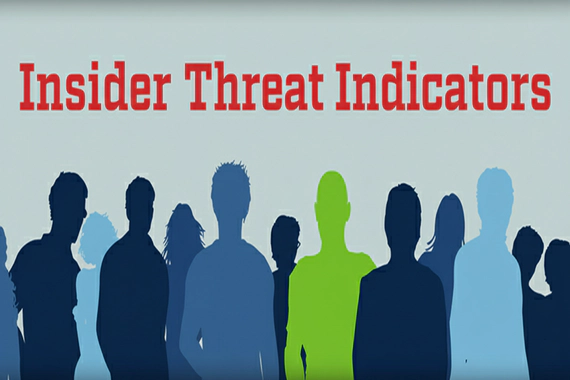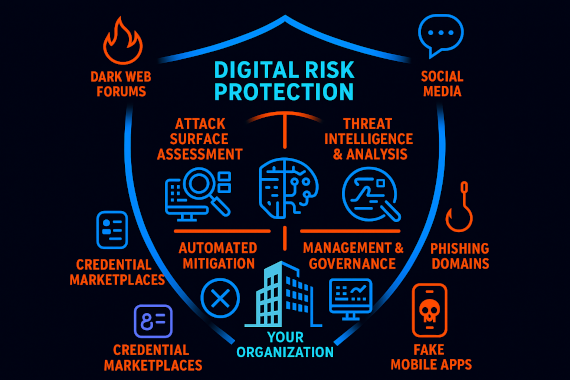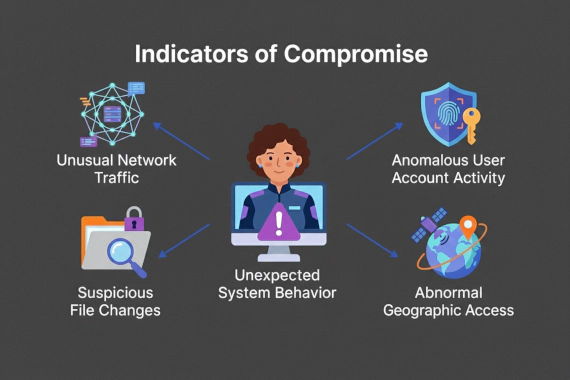
Insider Threat Indicators: How to Detect Internal Risks
Insider Threat Threat Intelligence Data Breach Prevention Security Operations
What Are Insider Threat Indicators? Security teams spend billions on perimeter defenses. Firewalls. EDR. Network …

Learn how Digital Risk Protection stops attacks before they reach your network by monitoring external threats.
• Traditional security tools monitor inside your network while attackers plan campaigns on dark web forums and social media.
• DRP operates inside-out by mapping your digital footprint and hunting threats targeting your specific assets, not generic threat intelligence.
• The four pillars are attack surface assessment, threat intelligence analysis, automated takedowns, and governance to measure effectiveness.
• Choose DRP platforms based on takedown success rates, monitoring coverage, and integration with your existing security tools.
Your firewall blocks external traffic. Your EDR stops endpoint threats. Your SIEM correlates internal logs. But none of these tools see what’s happening outside your network perimeter on dark web forums where attackers sell your credentials, phishing sites impersonating your brand, or paste sites where they leak your data.
Here’s the uncomfortable truth: 76% of organizations suffered attacks from exposed assets they didn’t know existed. Traditional security operates inside your perimeter. Attackers operate outside it, planning attacks in spaces your security stack can’t monitor.
Digital Risk Protection fills this visibility gap. It doesn’t replace your existing security tools. It extends your defenses beyond the network perimeter to stop threats before they reach your infrastructure.
Let’s break down what DRP actually is, how it differs from threat intelligence, and why organizations now treat it as a core security pillar.
Your firewall can’t stop attacks it never sees. That’s the problem DRP solves.
Digital Risk Protection continuously monitors and actively disrupts threats living outside your network perimeter. It tracks your organization’s external digital footprint across the open web, social media platforms, dark web marketplaces, paste sites, code repositories, and app stores. Then it stops attacks before they hit your network.
Your digital footprint is all the assets associated with your organization that exist online, including domains, subdomains, cloud instances, mobile apps, social media accounts, executive profiles, and employee credentials.
Here’s what makes DRP fundamentally different. Your firewall monitors network traffic. Your endpoint detection watches devices. Your SIEM analyzes internal logs. All of these tools operate inside your perimeter. DRP operates outside it, in the spaces where threat actors plan and often launch their attacks.
Think about where real attacks start. Threat actors aren’t testing your firewall rules first. They’re registering typosquatting domains that impersonate your brand. They’re buying credentials leaked from infostealers on dark web forums. They’re creating fake executive profiles on LinkedIn to launch spear phishing campaigns.
Your traditional security stack can’t see any of this happening. By the time these threats reach your organization, the attack is already underway. DRP catches them earlier in the kill chain, when they’re still being planned.
Consider the scale of external threats. Third-party breaches (often starting with compromised vendor credentials traded on dark web forums) appeared in 30% of all breaches (2025 DBIR). Meanwhile, 90% of CTI teams collect external data (SANS 2025 CTI Survey), but most lack the active takedown capabilities that define DRP.
That’s the visibility gap DRP solves. It’s not just monitoring external threats. It’s actively disrupting them before they become incidents your SOC has to respond to.
The Snowflake breach proves this gap is real. In 2024, attackers compromised over 160 Snowflake customer accounts using stolen credentials purchased from infostealer campaigns. Those credentials circulated on dark web forums for weeks before the attacks. External threat intelligence documented the exposure. But most victims never connected that external intelligence to their internal user accounts.
DRP would have caught this earlier. Continuous dark web monitoring detects compromised employee credentials. Automated alerts trigger password resets before attackers use them. The breach still required internal security failures, but DRP disrupts attacks before they reach your environment.
Understanding this operational model is critical. Let’s look at how DRP actually works in practice.
DRP follows a continuous cycle of discovery, monitoring, detection, and mitigation.
Asset Discovery: DRP discovers your attack surface including shadow IT, forgotten subdomains, mobile apps, cloud instances, and executive profiles. Discovery is continuous as organizations create new assets.
Continuous Monitoring: DRP scans external spaces across the surface web, dark web marketplaces, social media, paste sites, code repositories, and app stores. Dark web credential sales increased 25% in 2024 (IBM X-Force 2025). If you’re only monitoring surface web, you’re missing where credentials get traded.
Threat Detection: Automated scanning identifies threats specific to your organization. It’s alerts about YOUR credentials on dark web forums, phishing domains using YOUR brand name, or fake apps impersonating YOUR product.
Automated Mitigation: When threats are detected, DRP initiates automated takedown requests with hosting providers, domain registrars, and platforms.
Governance: DRP measures effectiveness through KPIs like Mean Time to Detect, takedown success rates, and cost avoidance.
Threats get caught and disrupted in hours or days instead of months.
But DRP isn’t a single tool. It’s built on four foundational pillars that work together. Let’s examine each one.
DRP isn’t a single tool you install and forget. It’s four interconnected capabilities working together.
Pillar 1: Digital Attack Surface Assessment
You can’t protect assets you don’t know exist. The first pillar continuously discovers your external attack surface including technical infrastructure, brand assets, executive profiles, and vendor systems. 62% of organizations said their attack surface grew over the past year.
Your attack surface is all the external-facing assets and touchpoints that attackers can see and potentially target, including domains, cloud instances, employee accounts, mobile apps, APIs, and third-party integrations.
Pillar 2: Threat Intelligence and Analysis
The second pillar translates raw data into actionable intelligence. Most data is noise. Threat intelligence filters signal from noise by contextualizing threats to your organization. Generic intelligence says “ALPHV/BlackCat is active.” Contextualized DRP intelligence says “ALPHV/BlackCat is targeting healthcare through Citrix vulnerabilities, and you have 3 exposed Citrix instances.”
Pillar 3: Automated Threat Mitigation
The third pillar takes action. Automated workflows initiate responses: takedown requests for phishing domains, reporting fake social accounts to platform abuse teams, forced password resets for leaked credentials.
Pillar 4: Management and Governance
The fourth pillar ensures DRP delivers measurable business value. Only 55% of organizations measure their CTI program effectiveness (SANS 2025 CTI Survey). Governance tracks threats detected, attacks disrupted, and losses prevented.
These four pillars work together. Asset assessment tells you what to monitor. Threat intelligence identifies threats. Automated mitigation disrupts them. Governance proves it works.
But why do organizations need DRP at all? Don’t traditional security tools handle external threats? Let’s address that question directly.
Traditional security tools do exactly what they’re designed to do: monitor and protect your perimeter. The problem? Attackers stopped attacking the perimeter years ago.
They’re not testing your firewall rules or trying to exploit your VPN. They’re registering phishing domains that look identical to yours, buying your employees’ credentials from dark web markets, and building attack infrastructure in spaces your security stack can’t even see.
Visibility: Your firewall sees traffic crossing your network boundary. It doesn’t see phishing domains registered in CT logs. Your EDR monitors endpoint behavior. It doesn’t see credentials sold on dark web marketplaces. Traditional tools can’t monitor spaces where attacks begin.
Timing: Traditional security is reactive. DRP is proactive. Threat actors register a typosquatting domain, build a phishing site over two weeks, then launch a campaign. Brand monitoring notices customer complaints. Takedown takes another week. That’s three weeks of active phishing. With DRP, domains get detected within hours. Takedowns begin immediately. Zero damage.
Scope: Traditional security focuses on technical threats. DRP covers technical threats plus brand impersonation, fraud, executive targeting, data exposure, and third-party risk. In 2024, 76% of incidents involved exposed assets like misconfigured cloud storage, public repositories with API keys, and partner systems lacking MFA.
Action: Traditional tools alert and block. DRP alerts, blocks, and removes threats through takedowns. When your firewall blocks a phishing domain, that domain still exists. When DRP takes down that domain, attackers start over.
Traditional security plays defense. DRP plays offense by disrupting attack infrastructure before it causes damage.
Understanding these limitations explains why organizations are adding DRP to their security stack. But what specific threats does DRP actually protect against? Let’s examine the most common use cases.
DRP addresses six major threat categories:
Brand Protection: Typosquatting domains, fake apps, and phishing sites impersonate your brand. DRP monitors domain registrations and app stores. Automated takedown workflows remove fraudulent content.
Credential Exposure: Employee credentials leaked in breaches get sold on dark web forums. Infostealer malware harvests corporate logins. Leaked credentials increased by 24% (Identity Threat Report 2025). DRP scans dark web marketplaces, paste sites, and GitHub repositories for your leaked data.
Executive and Social Media Threats: Fake executive profiles on LinkedIn launch spear phishing campaigns. Attackers run investment scams falsely claiming company endorsement. DRP monitors for fake accounts and impersonation. Automated reporting to platform abuse teams results in suspensions before damage occurs.
Supply Chain Risk: Vendor credential leaks affect your environment. Vendors with network access create direct pathways for attackers. Third-party attacks make up 30% of all breaches (2025 DBIR). DRP extends monitoring to vendor and partner assets.
Infrastructure Exposure: Misconfigured cloud storage, leaked source code on GitHub, and vulnerable external-facing services get scanned by threat actors. DRP continuously monitors for exposed infrastructure.
Traditional security tools handle threats that reach your perimeter. DRP handles threats before they get there.
But DRP platforms vary significantly in capabilities. Choosing the right solution requires careful evaluation. Let’s examine what to look for.
Selecting a DRP platform requires evaluating several factors that determine their effectiveness.
Coverage and Monitoring Scope: Does the platform monitor surface web, dark web forums, social media, mobile app stores, code repositories, and cloud infrastructure? Partial coverage creates blind spots. Ask vendors which spaces they monitor and scan frequency.
RECOMMENDED READING: Digital Risk Monitoring Guide
Detection and Intelligence Quality: How sophisticated is the threat detection? What are false positive rates? High false positives overwhelm teams. Request benchmark data on detection accuracy. Does the platform combine automated scanning with human analyst expertise? Platforms employing 100+ threat analysts contextualize threats to your business better than fully automated solutions.
Takedown and Mitigation: What’s the takedown success rate and speed? Success rates below 80% or manual-only processes indicate limited effectiveness.
Integration: Does the platform integrate with your security stack (SIEM, SOAR, TIP, EDR)? DRP platforms in isolation create work instead of reducing it. Integration feeds external threat data directly into your security stack so IOCs automatically update your detection rules without manual work.
Reporting and Measurement: Can you track KPIs and demonstrate ROI? Only 55% of organizations measure CTI program effectiveness (SANS 2025 CTI Survey). Without measurement capabilities, justifying investment becomes difficult.
Vendor Reputation: Can they provide customer references from organizations similar to yours? Do they have documented case studies showing measurable results? Choose vendors with proven track records, stable operations, and customers willing to vouch for them.
Red Flags to Avoid: Vendors positioning DRP as “just another threat feed” without takedown capabilities. Limited monitoring scope that only covers surface web. No API options for integration with your existing tools. Inability to demonstrate ROI metrics or customer success stories.
Ask vendors these three questions: What’s your takedown success rate by threat type? How do you integrate with SIEM and SOAR platforms? What KPIs do your customers track to measure effectiveness?
The answers reveal whether vendors deliver comprehensive DRP or limited point solutions.
Let’s be honest. DRP solves specific problems but creates new challenges.
Alert fatigue is real. Your team already drowns in alerts. DRP adds external threat notifications. Without proper tuning, you’ll get alerts about every typosquatting domain, paste site dump, and fake social account. Most won’t be relevant. Expect 3-6 months tuning detection rules.
Attack surface mapping takes time. It takes weeks or months to map shadow IT, forgotten subdomains, and cloud instances. You’ll discover assets you didn’t know existed, then realize you’re responsible for securing them.
Takedowns depend on third parties. DRP automates takedown requests but can’t force compliance. Some phishing domains come down in hours. Others take weeks or months. You’re dependent on processes you don’t control.
This isn’t cheap. Most enterprise DRP platforms cost $50K-$300K annually. Small businesses struggle to justify that investment. Budget solutions provide limited coverage that misses critical threats.
Go in with realistic expectations about implementation effort, alert management, and takedown limitations.
Here’s what matters: attackers already operate in the spaces your security stack can’t see. They’re registering phishing domains right now. Trading your employees’ credentials on dark web forums. Building fake apps that impersonate your product.
Your firewall won’t stop any of it because these threats never touch your perimeter until the attack is already underway.
DRP extends your defenses to where attacks actually begin. Not where they end up. It’s the difference between catching attackers during reconnaissance and discovering the breach six months later when it shows up in your SIEM logs.
Attackers are already working in these spaces. They’re not planning to start tomorrow. They’re active right now on dark web forums, registering domains, and trading credentials. Your next breach is probably being planned while you’re reading this.
The only question is whether you’re going to watch those spaces or keep pretending your firewall will catch everything.
Digital Risk Protection monitors threats outside your network perimeter across the open web, social media, and dark web. Unlike traditional security focused on internal defenses, DRP tracks your organization’s external digital footprint and disrupts attacks before they reach your network through automated remediation.
Cyber Threat Intelligence operates outside-in, analyzing the broad threat landscape to inform defensive strategy. Digital Risk Protection operates inside-out, starting from your specific digital assets and hunting threats targeting YOU. CTI is intelligence gathering (reports, feeds, analysis). DRP is active threat disruption (monitoring, detection, takedowns).
The five elements of digital risk management are: (1) identify exposed areas and assets across your external attack surface, (2) deploy an incident response plan for when threats are detected, (3) minimize the attack surface by removing unnecessary services, (4) monitor complete network access including external-facing systems, and (5) continuously monitor and improve security protocols based on threat intelligence. DRP automates steps 1, 4, and 5 by scanning external spaces for threats targeting your specific assets.
Prevention requires continuous external monitoring combined with automated threat mitigation. Implement DRP to monitor your digital footprint across the surface web, social media, and dark web. Automate takedowns of phishing domains and fake social accounts. Monitor credential leaks and assess third-party vendors’ exposure. Prevention isn’t a one-time thing, it requires continuous monitoring and rapid response.

Insider Threat Threat Intelligence Data Breach Prevention Security Operations
What Are Insider Threat Indicators? Security teams spend billions on perimeter defenses. Firewalls. EDR. Network …

Indicators of Compromise IOC Threat Intelligence Dark Web Monitoring Cybersecurity Breach Detection
IOCs work. But they work after the fact. By the time you find a malicious file hash or C2 beacon, attackers have already …